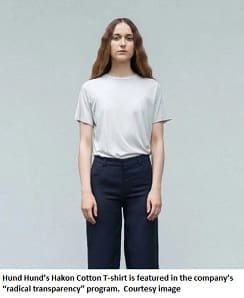Recycled materials and bio-based chemicals are making textiles greener.
By WWD Staff on February 11, 2020

Patagonia is a brand partner with Beyond Surface Technologies, which offers bio-based fabric finishes.
Over the past year, fiber suppliers, mills and fabric makers as well as apparel brands (across segments from fashion and activewear to denim and outerwear) have accelerated the development and launch of more sustainable textiles.
This includes cutting-edge technologies and breakthrough innovations such as the use of bio-based products along with increasing the deployment of materials featuring recycled post-consumer waste. Fiber ingredient companies, mills and apparel makers are also increasing efforts to publicly tout their green-ness via blogs, updated websites, detailed product labels and at trade shows and consumer events.
Many companies are “pulling the curtain back” by revealing to consumers the impact and cost of bringing sustainable products to market.
These efforts are in response to a growing demand by consumers for more sustainable and environmentally friendly products. Unable to escape dire news of climate change and its impact on the planet and people, consumers — especially Millennials and Generation Z — are taking cues from environmental activists and are rethinking purchases.
And while they may not be participating in the latest Extinction Rebellion protest, many consumers are actively choosing to eat less meat, repair items (including clothes) instead of buying new, shopping resale, upcycling fashion apparel and accessories and when they buy new, choose products and brands that are sustainable.
In a report last week from ING, researches at the firm said “consumer attitudes have reached a tipping point, leading them to avoid brands that don’t prioritize sustainability and environmental issues.” ING polled 15,000 consumers and found that 83 percent of those surveyed believe their “behavior” and purchasing choices can have a positive impact on addressing today’s environmental challenges.
Additionally, 61 percent of respondents said they would be “less willing to buy a company’s product if they discovered it was performing poorly on environmental practices,” ING said, adding that the report also highlighted “where consumers are already engaging in circular activities and their appetite for new product and service models.”
With “new product” initiatives, textile and apparel makers are turning to material science for the latest breakthroughs. And with these textile innovations, companies are not only thinking outside the box, but they’re also discarding it altogether. For example, at last month’s Future Fabrics Expo, in its ninth year, the focus was on ways to significantly reduce CO2.
The expo, in London, is managed by The Sustainable Angle and this year showcased sustainably produced processes such as “regenerative agriculture” and “biomimicry.” Nina Marenzi, founder and director at The Sustainable Angle, said the event’s “four main criteria for exhibitors are on water, waste, energy and biodiversity. Not all have to be met at once, however, the materials need to be safe and renewable, you won’t find toxic textiles in the showcase but there are lots of Tencel, chemically or mechanically recycled fibers, organic and regeneratively farmed fibers as well as low-impact denim.”
Beyond Surface Technologies, for example, has a goal of creating textile chemicals with the lowest environmental impact — without sacrificing performance. The company’s brand partners include Adidas, Patagonia and Levi Strauss & Co. as well as North Face, Puma and Gap. Its finishing products are for synthetics, cottons and blends and focus on wicking, water repellency and softness.
One of Beyond Surface Technologies’ latest offerings is “MiDori BioDry,” which is a USDA-certified, bio-based product that features plant-seed based active ingredients. The company describes it as a multipurpose fabric softener designed for various apparel items including denim. It is designed to enhance comfort while also absorbing wearer’s sweat and wicking away moisture. It also improves the performance of cotton fabrics, according to the company.
It’s important to note that while consumers demand greater sustainability in the products they choose, they also expect high performance. And while chemical finishes clearly help, fiber makers are also addressing this demand with new approaches to fiber design itself.
The Lycra Co., for example, has developed new fiber technology and insulation under its “EcoMade” brand. The company said its Lycra, Thermolite and Coolmax brands “all have EcoMade products that offer the same performance as their original fibers, but they are made with renewable and recycled content.”
In the fall of 2019, The Lycra Co. revealed plans to convert most of its Coolmax and Ther molite branded products to “post-consumer recycled versions” by 2021. Moreover, the company is working to help fast fashion brands elevate their sustainability efforts.

Julien Born, president of apparel at The Lycra Company. Courtesy image.
Julien Born, president of apparel at The Lycra Co., told WWD last month the company believes that “a migration from disposal fashion toward garment quality and longevity is happening in the fast-fashion space where we are partnering with several leading retailers.” Born said. “We see garment wear life, which is a core element of our Planet Agenda platform, as the industry’s best response to the sustainability challenge.”
Addressing the issue of performance was also showcased during the recent Outdoor Retailer show late last month. On display was Burlington’s Restora collection, which is an “eco-conscious” performance fabric made of recycled and sustainable content. Operating as part of Elevate Textiles, the firm also announced its 2025 sustainability commitments, which it said focuses on “responsible fiber sourcing” as well as reducing water consumption and lowering greenhouse gases.
The company’s differentiating content mix is inclusive of CiClo, which is a solution for addressing microfiber pollution that enables biodegradability in unrecycled and synthetic textiles. Also featured is Eco Circle, which is a recycled polyester fiber made of used polyester products through a unique recycling technology; and Seaqual, the plastic pollution initiative that cleans the oceans from marine litter, and its longstanding partner Repreve.
The company also debuted Repreve’s cationic-dyeable polyester and expanded “Repreve Our Oceans” offerings, which deliver 100 percent Repreve heathers and solids to the market, the company said, which allows for “deeper and brighter” colors, as well as improved color steadfastness and energy savings.
Meredith Boyd, who is senior vice president of Global Innovation at Unifi, said the company has “worked diligently to develop a 100 percent Repreve replacement for virgin cationic-dyeable fibers that is globally available. The popularity of heathers in apparel is bigger than ever, and this new global product offering is a great example of how Unifi continues to offer innovative products that meet the aesthetic, performance and sustainability demands of consumers.”
Other notable innovations include “bio-nylon,” which is being made by Italian nylon yarn firm Aquafil and California-based biotechnology company Genomatica. Christophe Schilling, chief executive officer of Genomatica, recently told WWD that caprolactam, the main ingredient in bio-nylon, is “an equivalent replacement [to crude-oil derived chemicals]; it’s the same molecule made in a better way.”
The bio-based material is still in the pilot stage. Two weeks ago, the company said in a statement that its bio-based nylon “has the potential to reduce greenhouse gas emissions in a $10 billion global industry that produces over five million tons of nylon-6 per year, to make carpet, clothing, car interiors, engineered plastics and food packaging.”
Schilling said 95 percent of U.S. consumers “think sustainability is a good goal and we’re seeing consumers demand more sustainable products. Our technology provides brands with a solution to meet this consumer demand for better-sourced products.”
Other trending bio-based breakthroughs include two solutions from Devan Chemicals: a bio-based antimicrobial called Bi-Ome Natural; and Tones of Cool Bio, a bio-based Phase Change Material.
The company’s Bi-Ome Natural solution aims to guarantee freshness and hygiene for textiles through active ingredients, which are natural, organic, GMO-free, biodegradable and recyclable. It includes liquids and derivatives such as linseed oil, which is obtained from dried, ripened flax seeds, and Chrysanthemum, made from the seeds of daisies.
Devan said many plants and flowers “produce antimicrobial chemicals as a defense mechanism toward threats like bacteria, fungi and molds. More and more natural antimicrobials are used in food and cosmetics as a preservative. As known, the bedding industry and more and more governments are planning to invoke regulations on recyclability. Therefore, technologies such as Bi-Ome Natural, which are recyclable, could gain more interest over time.”
Aside from bio-based and use of recycled materials, recent textile innovations include “cradle-to-cradle” certified materials. This past fall, G-Star Raw introduced the first cradle to cradle-certified Gold Stretch denim fabric. It’s a material that features 2 percent premium degradable stretch fiber.
The rollout was done in partnership with solution provider DyStar and Pakistan-based denim mill Artistic Milliners. The fiber is called Roica V550, and is sourced from Japan and holds a Gold Material Health Certificate from the C2C Products Innovation Institute.
G-Star Raw’s integration of the fiber aims to enhance its Gold denim fabric that was certified in 2018. Adriana Galijasevic, denim and sustainability expert at G-Star Raw, told WWD in December that by “continuously pushing the boundaries of our sustainable innovations and by scaling them throughout our collections, we empower customers with a choice to join the change for good.”
Again, the end goals with all of these innovations is help consumers make choices that align with their personal goals of helping the planet, and living a more sustainable life. And increasingly, apparel brands and textile firms are making it easier for the consumer to learn more about these innovations to help in their decision-making. This includes hang-tags with detailed sustainability information (including certifications), and educational websites written in laymen’s terms.
Dovetailing with these sustainability initiatives is a push for greater transparency. German apparel brand Hund Hund, for example, has launched “Radical Transparency,” which fully discloses the cost of bringing fashion to market. The company’s website breaks down the various for each product, including materials, transportation, packaging, labor and taxes. Doing so, the company believes, helps consumers to make better choices.
“At Hund Hund, we make it a focus to work with small-scale producers within Europe to ensure fair working conditions,” the company explained. “Where we can possibly make the prices and quality work, we try to work with more environmentally sustainable materials.”
“Firstly, we avoid synthetic fabrics such as polyester which are plastics made from fossil fuels which never bio-degrade,” Hund Hund stated on its site. “Our main leather is vegetable-tanned with bark which uses no chemicals. Our main jersey uses 67 percent Tencel which is a natural Eucalyptus-based fabric which consumes much less water than cotton and has a closed-loop process which minimizes waste.”
The apparel brand said that it regards reducing its environmental impact “as a long-term and challenging process but like our customers, by shifting more and more of our buying to more ethical suppliers we can play a small part in creating a better world.”



